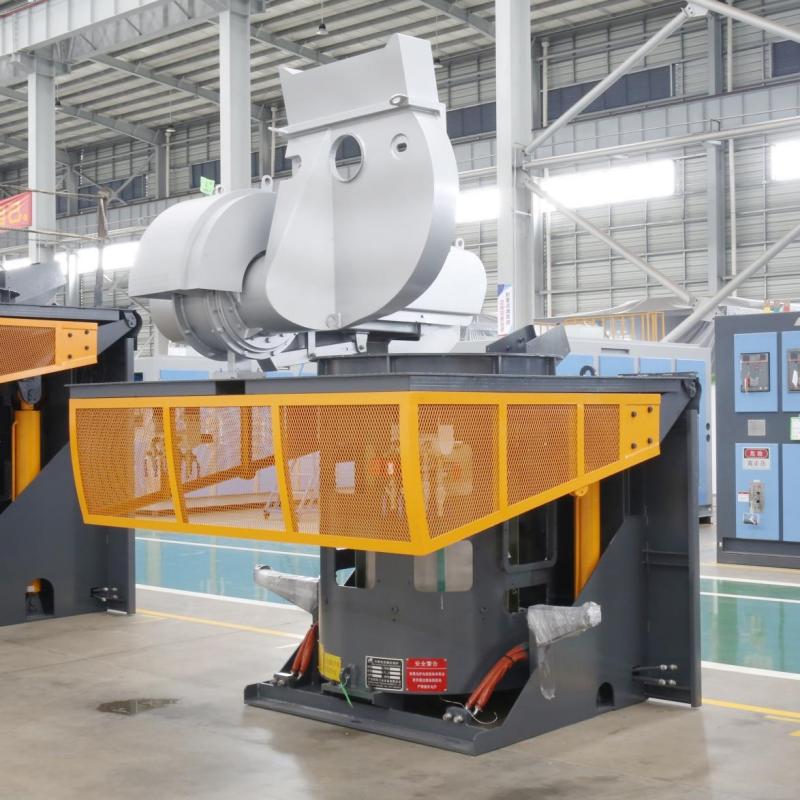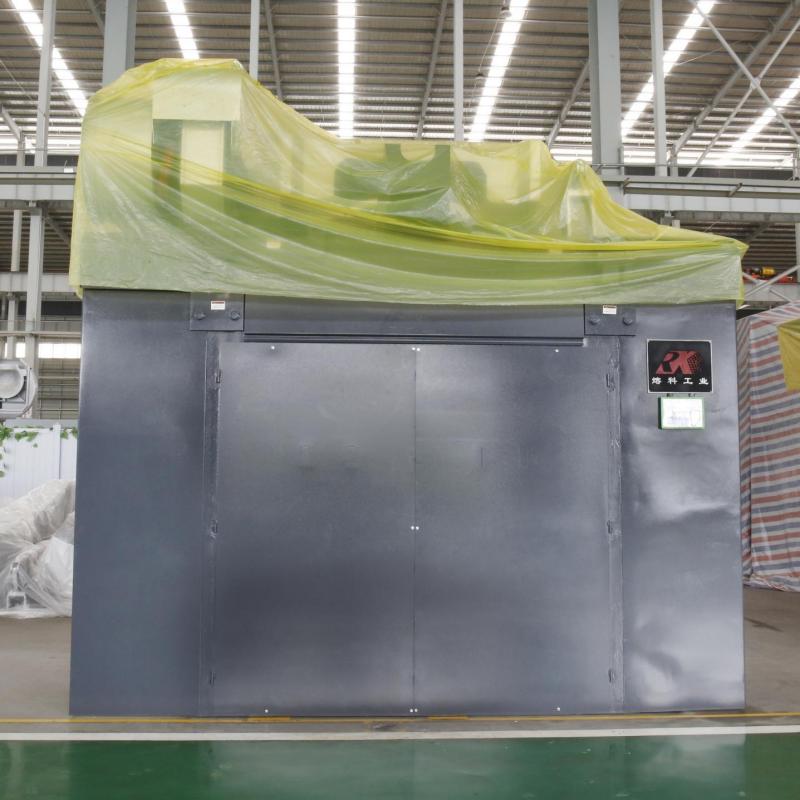
Innovative Melting Solutions: Intermediate Frequency Induction Furnace for Metals
Advanced melting technologies are indispensable in metalworking for enhancing production efficiency and quality. Rongke’s intermediate frequency (IF) induction furnaces lead this evolution with advanced technology and design, revolutionizing the industry. Featuring interactive windows and high-quality materials, these furnaces exemplify superior craftsmanship and processing capabilities. This not only enhances safety and stability in production but also significantly improves energy efficiency. Rongke’s innovative Intermediate Frequency Coreless Induction Furnace establishes a new benchmark, representing the epitome of quality and technological advancement in the field.

Understanding Intermediate Frequency Induction Furnaces
Definition and Working Principle of IF Induction Furnaces
Intermediate frequency (IF) induction furnaces are advanced melting devices that use electromagnetic induction to heat and melt metals. The working principle involves generating an alternating current through a coil, which creates a magnetic field. This field induces currents in the metal charge, causing it to heat up and eventually melt. Rongke’s IF induction furnaces come with an IDE furnace leakage alarm system, ensuring safety and reliability. The system boasts a patented design and is certified by the EU CE safety system.
Rongke IDE Full-Time and All-Round Furnace Leakage Alarm System
Rongke’s IDE full-time and all-around furnace leakage alarm system is a crucial safety feature. The leakage detection principle involves monitoring for molten iron seepage through furnace lining gaps. When the molten iron contacts the current detection electrode, a leakage current alarm is triggered. If it reaches the coil, the voltage detection circuit sounds alarms and pinpoints the specific location. The grounding alarm detection principle activates when molten iron penetrates within 2cm of the coil, causing the leakage current to exceed set values or increase coolant conductivity. This intelligent system promptly triggers alarms, ensuring enhanced safety.
Leading Energy Saving and Repeatedly Pioneering
Energy efficiency is a hallmark of Rongke’s IF induction furnaces. The coil, being the furnace’s heart, uses TU1 grade oxygen-free copper from Chinalco Luoyang Copper Co., Ltd. These coils are crafted from the thickest wall copper tubes via a cold extrusion process and utilize double coil technology for superior energy efficiency. This design not only saves energy but also improves overall furnace performance.
Magnet Yoke Technology
Rongke’s magnet yoke technology is another innovative feature. Made from high-quality cold-rolling directional silicon steel sheets, the magnet yoke minimizes magnetic loss to less than 105 and boasts a coverage rate exceeding 70%. The magnet yoke supports the induction coil from all directions and concentrates the magnetic field on the molten bath. Additionally, water flows through both sides of the magnet yoke, balancing heat dissipation and extending its working life. This maintenance-free design integrates cooling and support functions, enhancing durability and efficiency. Premium silicon steel sheets and superior design result in low magnetic loss, minimal heat production, and extended operational life.
Advantages of IF Induction Furnaces
Energy Efficiency and Cost-Effectiveness
IF induction furnaces offer significant energy efficiency and cost savings compared to other melting methods. They operate with 30% less noise than similar products and feature a fully enclosed furnace shell, which prevents coil ignition due to dust pollution. This enclosed design also provides secondary shielding for the coil’s magnetic field, reducing magnetic radiation to just 10% of that produced by similar products and well below national standards.
Precise Control Over Melting Temperatures and Heating Rates
These furnaces provide precise control over melting temperatures and heating rates, crucial for producing high-quality metal products. The ability to finely tune these parameters ensures optimal melting conditions, enhancing product quality and consistency.
Reduced Oxidation and Material Loss
IF induction furnaces also minimize oxidation and material loss during the melting process. The controlled environment and efficient heating methods reduce the exposure of molten metals to air, limiting oxidation and conserving valuable materials. This results in higher yields and better quality metal products, making IF induction furnaces an advantageous choice for modern metalworking applications.

Applications of IF Induction Furnaces
Metal Casting and Foundries
IF induction furnaces are pivotal in metal casting and foundries due to their precise temperature control and melting rate management. These capabilities are essential for crafting high-quality castings across various metals like iron, aluminum, and copper. Their efficiency in melting metals swiftly and effectively makes them indispensable in the casting sector, ensuring consistent production of intricate and flawless metal parts.
Steel and Stainless Steel Production
IF induction furnaces play a critical role in the production of steel and stainless steel. These furnaces achieve the high temperatures necessary for melting steel while meticulously controlling the chemical composition of the molten metal. This precision is crucial for manufacturing superior-grade steel products. Additionally, their energy efficiency contributes to cost reduction and minimizes environmental impact, establishing them as preferred equipment in the steel industry.
Recycling Industries and Non-Ferrous Metal Melting
IF induction furnaces are instrumental in recycling industries and the melting of non-ferrous metals. They excel in efficiently melting scrap metal, facilitating the recycling of materials like aluminum, copper, and brass. This process not only conserves natural resources but also reduces energy consumption and greenhouse gas emissions. The versatility and effectiveness of IF induction furnaces make them ideal for recycling operations and the production of non-ferrous metal products.
Features to Consider in IF Induction Furnaces
Capacity and Scalability Options
When choosing an IF induction furnace, it’s crucial to consider its capacity and scalability. Selecting a furnace that can handle current production volumes while offering flexibility for future growth is essential. Rongke’s range of furnaces comes in various capacities, ensuring businesses can find a model that meets specific production needs and accommodates future expansions.
Safety Features and Operational Controls
Safety features and operational controls are paramount in IF induction furnaces. Look for furnaces equipped with advanced safety systems, such as Rongke’s IDE full-time and all-round furnace leakage alarm system. This system provides real-time monitoring and alerts for potential issues, enhancing operational safety. Precise operational controls for temperature and melting parameters are also critical for maintaining product quality and ensuring safe operation.
Maintenance Requirements and Longevity
Consider the maintenance requirements and longevity of the furnace when making a selection. Opt for furnaces designed for easy maintenance and known for durability. Rongke’s IF induction furnaces, with their high-quality materials and innovative design, offer extended operational life and reduced maintenance needs. This ensures long-term reliability and cost-effectiveness for businesses.
Future Trends and Innovations
Emerging Technologies in IF Induction Furnace Design
Advancements in materials science and engineering are continuously enhancing IF induction furnace design and functionality. Improved coil designs and advanced cooling systems are among the innovations contributing to better performance and longevity. Staying updated on these technological developments enables businesses to choose the most efficient and advanced furnace models available.
Potential Advancements in Efficiency, Automation, and Integration with IoT
The future of IF induction furnaces lies in increased efficiency, automation, and integration with the Internet of Things (IoT). Smarter energy management and optimized furnace designs are enhancing efficiency levels. Automation technologies are streamlining operations, reducing labor costs, and improving safety. Integration with IoT allows for real-time monitoring, data analysis, and predictive maintenance, optimizing overall furnace performance. These advancements promise to revolutionize the metalworking industry further, making IF induction furnaces even more essential for modern manufacturing processes.
Closing Words
Advanced melting technologies play a crucial role in metalworking by boosting production efficiency and enhancing product quality. Leading this evolution are Rongke’s intermediate frequency (IF) induction furnaces, renowned for their state-of-the-art technology and innovative design, which are revolutionizing the industry. These furnaces are distinguished by their interactive windows and use of high-quality materials, showcasing superior craftsmanship and advanced processing capabilities. This not only ensures a safer and more stable production environment but also delivers significant improvements in energy efficiency. Rongke’s pioneering Intermediate Frequency Coreless Induction Furnace sets a new standard, representing the epitome of quality and technological advancement in metalworking. With their wide-ranging applications, robust features, and continual innovations, these furnaces are poised to remain indispensable in modern manufacturing processes.




